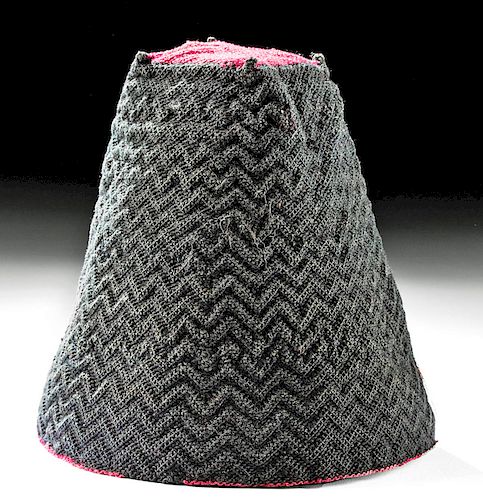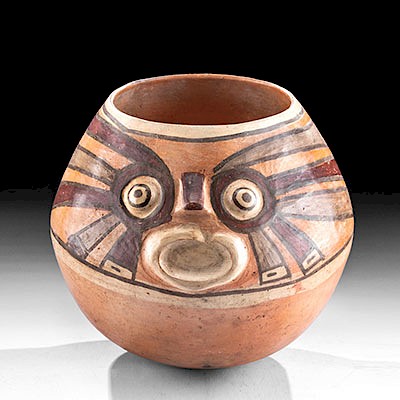Tiahuanaco Camelid Fiber Four-Cornered Hat
Lot 113a
About Seller
Artemis Gallery
686 S Taylor Ave, Ste 106
Louisville, CO 80027
United States
Selling antiquities, ancient and ethnographic art online since 1993, Artemis Gallery specializes in Classical Antiquities (Egyptian, Greek, Roman, Near Eastern), Asian, Pre-Columbian, African / Tribal / Oceanographic art. Our extensive inventory includes pottery, stone, metal, wood, glass and textil...Read more
Estimate:
$1,000 - $1,500
Absentee vs Live bid
Two ways to bid:
- Leave a max absentee bid and the platform will bid on your behalf up to your maximum bid during the live auction.
- Bid live during the auction and your bids will be submitted real-time to the auctioneer.
Bid Increments
| Price | Bid Increment |
|---|---|
| $0 | $25 |
| $300 | $50 |
| $1,000 | $100 |
| $2,000 | $250 |
| $5,000 | $500 |
| $10,000 | $1,000 |
| $20,000 | $2,500 |
| $50,000 | $5,000 |
| $100,000 | $10,000 |
| $200,000 | $20,000 |
About Auction
By Artemis Gallery
Dec 5, 2019
Set Reminder
2019-12-05 10:00:00
2019-12-05 10:00:00
America/New_York
Bidsquare
Bidsquare : Ancient / Ethnographic - Holiday Edition
https://www.bidsquare.com/auctions/artemis-gallery/ancient-ethnographic---holiday-edition-4710
What to give this holiday season? Ancient & Ethnographic Art of course! Our special Holiday auction features hundreds of unique finds from all over the world. Artemis Gallery info@artemisgallery.com
What to give this holiday season? Ancient & Ethnographic Art of course! Our special Holiday auction features hundreds of unique finds from all over the world. Artemis Gallery info@artemisgallery.com
- Lot Description
Pre-Columbian, Chile, Tiahuanaco (also Tiwanaku), ca. 400 to 700 CE. A finely woven, four-cornered hat of a rather high form, featuring a square crown and pointed tips, the yarns dyed black for the perimeter of the had and cochineal red on the square top with a narrow band of cochineal red trim around the rim. Four-cornered hats, made by both the Tiwanaku and the Wari/Huari, were comprised of camelid fibers that were skillfully prepared into yarns and dyed. Artists from both cultures also favored similar geometric designs, including crosses, diamonds, as well as the stepped triangles we see adorning this hat. Size: 7" in diameter x 6.875" H (17.8 cm x 17.5 cm)
An informative essay on the Metropolitan Museum of Art website presents a nice discussion about techniques that are specific to the Wari/Huari and Tiwanaku four-cornered hats: "Although they shared certain technological traditions, such as complex tapestry weaving and knotting techniques, the Wari and the Tiwanaku utilized significantly different construction methods to create four-cornered hats. Wari artists typically fashioned the top and corner peaks as separate parts and later assembled them together. Tiwanaku artists generally knotted from the top down, starting with the top and four peaks, to create a single piece. In addition, four-cornered hats knotted with pile have largely been discovered at Wari sites, while those knotted without pile have been found in Tiwanaku burials. Through these variances, scholars have been able to attribute individual works to one group or the other."
Provenance: ex-private Hans Juergen Westermann collection, Germany, collected 1950 to 1960s
All items legal to buy/sell under U.S. Statute covering cultural patrimony Code 2600, CHAPTER 14, and are guaranteed to be as described or your money back.
A Certificate of Authenticity will accompany all winning bids.
We ship worldwide and handle all shipping in-house for your convenience.
#150876Hat is lined with black museum-quality fabric and set on a custom form for optimal display. Minor losses to red trim on the bottom. A few areas of loose/missing fibers from the red square crown and the black walls of the hat, but in overall remarkable condition - a credit to the arid climate of its place of origin.Condition
- Shipping Info
-
All shipping is handled in-house for your convenience. Your invoice from Artemis Gallery will include shipping calculation instructions. If in doubt, please inquire BEFORE bidding for estimated shipping costs for individual items.
-
- Buyer's Premium



 EUR
EUR CAD
CAD AUD
AUD GBP
GBP MXN
MXN HKD
HKD CNY
CNY MYR
MYR SEK
SEK SGD
SGD CHF
CHF THB
THB














